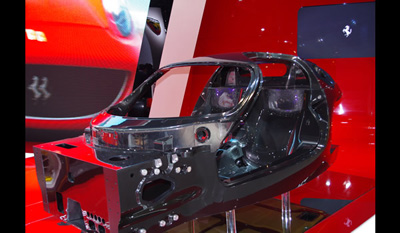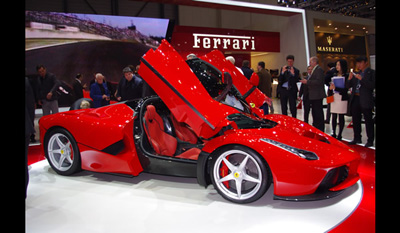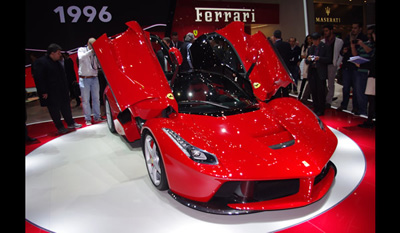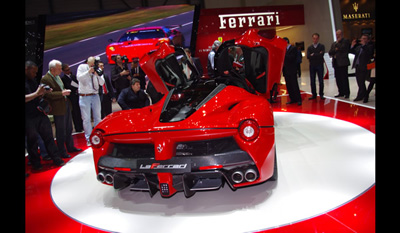Ferrari LaFerrari Hy Kers 2013
The new Ferrari supercar succeeding to the Enzo finally was launched at the 2013 Geneva Motor Show. It is the most sophisticated Ferrari homologated for the road with a combination of mid engine V12 and Hy Kers system electric motor. The design of the body was extensively developed in wind tunnel. It is called LaFerrari. Only 499 LaFerrari will be produced.
Here is the official introductory explanation: We chose to call this model LaFerrari because it is the maximum expression of what defines our company – excellence. Excellence is in terms of technological innovation, performance, visionary design and the sheer thrill of driving. Aimed at our collectors, this is a truly extraordinary car which encompasses advanced solutions that, in the future, will find their way onto the rest of the range, and it represents the benchmark for the entire automotive industry. LaFerrari is the finest expression of our company’s unique, unparalleled engineering and design know-how, including that acquired in Formula 1.
The LaFerrari is constructed around a carbon fibre structure already unveiled at 2012 Paris Mondial. (see photos N°27/28 and 28/28 above). The power-train includes Hy-Kers system inspired by Formula One technology recovering braking energy for an additional propulsion power. The electric energy is stored in complex high power battery weighting 60 kg. The electric motor has a maximum power of 120 kW (163 hp) and maximum torque of 270 Nm (28 kgm). The 65° V12 engine has a capacity of 6.262 cc (328.1 cu.in.) and has a maximum power of 588 kW (800 hp) at 9.000 rpm while the maximum torque is announced for 700 Nm (71 kgm) at 6.500 rpm.
The maximum speed is claimed at over 350 kph (217 mph) while 0 to 100 kph (62 mph) is announced to require below 3 seconds. 0 to 300 kph (186 mph) is claimed to be completed in 15 seconds.
Official Press Release content
The LaFerrari represents Ferrari’s most ambitious project yet to push the boundaries of technology on a road car, drawing together the finest expression of the marque’s technical capabilities in both GT and Formula 1 engineering. It boasts the most extreme performance ever achieved by a Ferrari production car and features the most advanced and innovative technical solutions which will, in the future, filter down to the rest of the Ferrari range. With production limited to just 499 examples, LaFerrari continues Ferrari’s tradition in building uncompromising performance cars for a small number of highly discerning clients.
ARCHITECTURE
The LaFerrari’s architecture represents the pinnacle of innovation even by Ferrari’s legendary standards. The objective was to increase aerodynamic efficiency, deliver ideal weight distribution, lower the car’s centre of gravity as far as possible, and, most importantly of all, seamlessly integrate the new hybrid system. All of this and more has been achieved without impinging on cabin space, comfort or accessibility.
Compared to the last limited series special the bodywork is narrower and lower to achieve maximum aerodynamic efficiency. The centre of gravity was lowered by 35 mm by redesigning the layout and integration of all of the main components and the human-machine interface, resulting in superior handling and responsiveness. Completely revised weight distribution means that the masses are now inside the wheelbase, guaranteeing the LaFerrari a low polar moment of inertia, excellent stability and grip in all driving conditions with 59 per cent of the weight over the rear of the car.
One of the greatest challenges in designing the LaFerrari was incorporating the hybrid system. Despite having the same wheelbase and maximum overall length as the Enzo, the LaFerrari incorporates both the hybrid system and the F1 dual-clutch gearbox plus their cooling systems. In other words, thanks to some extremely meticulous and ingenious engineering and design work, the running gear of two cars is cleverly packaged in the same space as previously occupied by just one.
Drawing on the ergonomically efficient F1 driving position, in which the driver is lower in the car and more reclined, the LaFerrari’s cockpit features a greater inclination of the driver’s upper body, legs and arms. The LaFerrari thus becomes the meeting point between sports car and F1 single-seater. This was achieved by integrating a fixed, bespoke seat lower in the chassis to improve the driver’s sensitivity to the vehicle’s dynamic behaviour.
The pedal box is adjustable to ensure that the driver’s legs are at the correct angle to allow absolutely precise control of both brake and accelerator. Similarly the new, smaller steering wheel is adjustable for reach and in height. Thanks to the chassis design and door aperture, the car is easier to get in and out of without reducing cockpit space.
POWERTRAIN
The LaFerrari is the first ever car with hybrid technology to come out of Maranello. The 6262cc V12 produces 800 CV and the electric motor a further 12o kW (163 CV) for a total of over 960 CV. Thanks to the huge technological leap forward represented by the HY-KERS system, the LaFerrari is the most high performance and efficient Ferrari ever built.
Making full use of Ferrari’s F1 expertise with KERS systems which has been further developed for application to road cars, the HY-KERS guarantees maximum integration between the V12 and the electric motor, seamlessly blending extreme performance with maximum efficiency. The high levels of torque available at low revs from the electric motor allowed the engineers to optimise the internal combustion engine’s performance at higher revs, thus providing unending power throughout the rev range and a maximum torque peak of over 900 Nm.
This solution has not involved any increase in the car’s dimensions or its wheelbase and has, in fact, helped lower its centre of gravity. The F1 dual-clutch gearbox is coupled with the electric motor and an auxiliary electric motor replaces the traditional alternator, thus saving weight and reducing the overall dimensions of the packaging. In addition, the HY-KERS solution was designed from the outset to be flexible and modular to enable its evolution for application to other models in the range.
The electric motor was designed employing High Specific Power Density technology which enabled the engineers to drastically reduce weight and volume in relation to available torque. The result is performance figures that are comparable to those of the F1 car with the same torque density and the same efficiency (94%) or, in other words, very limited power dissipation.
Battery size was an essential factor in optimising the HY-KERS’ weight-power ratio with the aim being to maximise performance while reducing fuel consumption. The solution was an extremely complex system consisting of 120 cells assembled into eight 15-cell modules, with a power output that’s the equivalent of 40 traditional batteries but weighing just 60 kg. The high-voltage batteries are actually assembled in-house by the Scuderia racing department.
The batteries are charged in two different ways: under braking – even hard braking when the ABS intervenes, such as when driving on a track – and every time the V12 produces more torque than required, such as in cornering. In the latter instance, rather than the being sent to the wheels, the excess torque is converted to energy and stored in the batteries.
The HY-KERS system is governed by the Hybrid Power Unit which controls the power delivery from both the V12 and the electric motor via two inverters and two DC-DC converters. The variable-frequency control makes torque delivery rapid and precise.
This technology has enabled Ferrari’s engineers to maximise performance and reduce fuel consumption. C02 emissions have been reduced to 330 g/km without resorting to electric-only drive which was not within the mission of this model. The HY-KERS system is, however, designed so that in future applications a car can be driven using exclusively electric power for a few kilometres and, during development testing, a full-electric version of LaFerrari achieved just 220 g/km of C02 emissions on the combined cycle.
THE V12
The 6262 cc V12 is the most powerful naturally-aspirated engine ever used on Ferrari a road car. As well as producing 800 CV, the V12 spins to 9250 rpm which guarantees fantastic performance and driving pleasure as well as that unmistakable Ferrari V12 sound.
These completely unprecedented results can be attributed to work carried out in three areas: volumetric, mechanical and combustion efficiency. To increase volumetric efficiency, the LaFerrari employs continuously variable-length intakes – a mainstay in F1 engine technology until rule changes banned its use – which boost performance. As the length of the inlet tracts vary in line with engine speed, the torque and power curves are optimised across the rev range to suit the torque output of the electric motor. Total torque generated by the V12 together with the electric motor is over 900 Nm, with the instantaneous torque from the electric motor being employed at lower revs and with the V12 engine power and torque optimised at higher revs. The V12’s peak torque of 700 Nm is in fact developed at 6750 rpm.
In addition the entire intake system – from the dynamic air intakes on the top of the rear wheelarches to the intake plenum – was designed to maximise intake volume efficiency. The engine also boasts a very high 13.5:1 compression ratio for maximum combustion chamber efficiency.
Improvements in mechanical efficiency involved a number of components, most importantly the crankshaft which has been lightened and incorporates new, more aerodynamically efficient counter webs to reduce pumping losses. The crankshaft design also reduces masses around the rotation axis which cut overall mass by around 19 per cent.
Last but not least, one of the LaFerrari’s signatures is its engine sound. Thanks to tuning of the exhaust in particular, the LaFerrari has an unmistakable Ferrari V12 soundtrack. The equal-length 6-into-1 exhaust system was hydroformed using Inconel as in F1 to help keep overall weight down with the additional benefit of very high temperature resistance characteristics.
 |
 |
CHASSIS AND BODYSHELL
To attain the performance goals set for the LaFerrari, Ferrari drew not only on the Scuderia’s F1 experience in the choice of materials, design and engineering, but brought in the expertise of Rory Byrne, the legendary F1 designer who was responsible for no fewer than 11 of Ferrari’s World Championship-winning cars.
A working group of GT and F1 engineers designed a chassis which would provide maximum rigidity and minimum weight, despite the constraints imposed by incorporating the hybrid system. During the engineering phase a number of functions were integrated within the chassis design to reduce weight. One example is the seat structure which is part of the chassis, lowering weight and ensuring a more compact architecture and a lower centre of gravity. These uncompromising solutions guaranteed a significant improvement in performance characteristics over the chassis of the Enzo Ferrari, with torsional rigidity increased by 27 per cent and beam stiffness up by 22 per cent, while weight has dropped by 20 per cent.
The chassis is built entirely in-house in Maranello alongside the F1 single-seaters using the Scuderia’s materials and production processes. Just like in F1, pre-preg composites of aeronautical derivation are employed: four different types of carbon-fibre are used, because each area of the body-in-black is engineered to guarantee the functional requirements it has to meet.
Most of the tub is made of T800 – a first in the automotive sector – with both fabric and unidirectional tape being strategically hand laid up to ensure that the right material is in the right place.
T1000 unidirectional tape and fabric is used in areas that are important for passenger compartment protection, such as the doors and the sills. Its high energy absorption characteristics pass the strictest side-impact legislation norms. Structural elements of the body are made using M46J unidirectional tape and fabric which is extremely rigid, but lightweight.
For the underbody, carbon-fibre is combined with another specialist composite material, Kevlar®, which is used to protect the carbon structure from road debris damage.
The multi-material approach was adopted for the entire body-in-black in order to reduce the number of components to the benefit of lower weight. An example is the one-piece rear section, which is a single piece hand laid-up using a combination of M46J and T800 carbon-fibres to obtain a very lightweight, yet rigid structure.
The carbon-fibre is cured in the same autoclaves used for the F1 chassis in two phases between 130°and 150° C using vacuum bags to remove any voids in the laminate.
AERODYNAMICS
Aerodynamics play an essential role in the LaFerrari’s exceptional performance and are further example of the uncompromising carry-over of F1 technology to Ferrari’s production models. The engineers’ aim was to deliver the highest degree of aerodynamic efficiency ever achieved with any road car, with a coefficient of nearly 3, thanks to technical solutions honed with CFD analysis and fine-tuned in the F1 Wind Tunnel. Working closely with the aerodynamics department, Ferrari’s Styling Centre incorporated these advanced solutions into the car’s design and the result is the perfect balance of form and function, making the most efficient use of the air flows around and through the car’s body.
What makes this design so innovative is its use of active aerodynamics conceived as a seamless integration of the car’s other dynamic control systems to deliver a genuine breakthrough in overall performance. The integration with the car’s controls and dynamic parameters ensures that the active aerodynamics adjust continually to hone both the downforce and its balance via the front and rear devices. In this way the LaFerrari combines the maximum downforce and minimum drag coefficient at every speed and in every driving condition.
Thanks to its low height and reduced overall width, the LaFerrari has an extremely compact frontal section for low drag and the tapered, streamlined shape of the greenhouse optimises the air flow towards the rear cooling intakes.
The front wing was designed specifically to increase downforce by eliminating the negative effects of pitch sensitivity caused by the pronounced splitters. A broad central air vent on the front bonnet channels hot air away from the radiator. The front spoiler directs the external flow to the front of the outlet to improve its efficiency, thus creating compression on the front section of the bonnet which generates downforce. A central flap helps keep the airstream from the vent close to the bodywork to reduce the wake, while the rear radius of the vent reduces drag.
The scallop behind the front wheelarches boosts the extraction of air from around the wheels and improves the efficiency of the front diffuser as well as increasing downforce. The front wheelarches direct the airflow downwards which is then channelled by the flanks along the groove of the doors to the rear radiators.
At the rear of the car, a pair of engine air intakes on the top of the rear wheelarches boost dynamic ram effect which increases power output by 5 CV. The shape of the one-piece rear section and spoiler are designed to maximise downforce.
Meticulous development work was dedicated to perfecting airflow under the car with where a number of advanced solutions were adopted directly from F1. These include front vortex generators to boost downforce and efficiency.
A central dam at the front of the car improves the efficiency of the spoiler and the forward section of the underbody. This area in front of the wheels incorporates diffusers which feature different expansion characteristics for the front and the outside of the tyre, with vertical fences which maximise the extraction capacity.
The active aerodynamics package on the underbody of the car plays an essential role as it completely changes the configuration below the car as the active rear spoiler is deployed:
• The flaps on the rear diffuser rise to increase air expansion and thus extraction capacity
• The flaps on the front diffuser rise to increase expansion and generate the downforce required to balance that at the rear
• The guide vane on the front underbody, which at high speeds channels excess air away from the front radiator to reduce drag, closes to maximise efficiency.
 |
 |
STYLING
The LaFerrari perfectly melds cutting-edge formal and aesthetic research and aerodynamic functionality, a result achieved by the synergies – from the start of the model’s inception – between Ferrari’s Styling Centre, headed by design chief Flavio Manzoni, and the engineering and development departments.
The LaFerrari’s overall silhouette and proportions are the very natural product of its architecture and the layout of its hybrid running gear. The design is striking and innovative, yet its sleek profile remains true to Ferrari’s classic mid-rear longitudinal V12 sports car archetype: the cabin and engine compartment volumes are contained within the wheelbase to achieve the best possible balance of its masses. Impressively, the addition of the HY-KERS system has not resulted in an increase in dimensions, but a better balance between the car’s front and rear overhangs.
Seen from the side the car has a sharp, downward-sloping nose and a very low bonnet which emphasises its muscular wheelarches. The result is strongly reminiscent of the gloriously exuberant forms of late-1960s Ferrari sports prototypes, such as the 330 P4 and the 312P. The ratio of the front and wheelarch dimensions are also very much in line with Ferrari tradition.
The LaFerrari’s body has been given a sculptural treatment heavily influenced by its aerodynamics. Its elegantly sculpted forms lend a sense of huge power and aggression to the wheelarches, with surfaces flowing fluidly rearwards over the cockpit and beautifully resolved forms that give shape to the volumes themselves. This fluid surface treatment provides both the exceptional drag and downforce characteristics required by the aerodynamicists, as well as very efficiently channelling air to the components requiring cooling.
The car’s front section incorporates a lower front wing that appears suspended on a single central pylon beneath the nose, a clearly F1-inspired choice. Nowhere is the car’s extreme, sporty character more evident than in its tail section where its muscular power is uncompromisingly revealed. Here two deep grooves emerge from the interplay of surfaces over the imposing wheelarches. These efficiently channel hot air from the engine bay and in doing so contribute to boosting downforce at the rear of the car.
The engine compartment ends in a full-width nolder beneath which is concealed an unprecedented active aerodynamic device. Sitting on a central pylon, which is stylistically reminiscent of the front one and which also serves to shield the HY-KERS system, is a large adjustable spoiler which deploys automatically and does not impinge upon the sleek design of the tail.
The lower section of the tail features bare carbon-fibre and is dominated by deep apertures and a generous diffuser equipped with movable flaps that adjust when the motorised spoiler is deployed.
The LaFerrari’s driving position is an entirely new concept and draws heavily on F1. Both Fernando Alonso and Felipe Massa were directly involved in its development, resulting in a functional cockpit that is track-inspired, delivering the perfect marriage of tradition and modernity. The ergonomics of the LaFerrari’s driving position actually turn conventional road car concepts on their heads and has a design normally seen only in racing cars: the seat is fixed but both the steering wheel and pedal box are highly adjustable to accommodate the driver’s preferred position.
The door panels are a genuinely integrated part of the cabin design as their sculpted carbon-fibre shells sleekly and efficiently hug its forms to afford occupants the greatest possible freedom of movement.
The LaFerrari’s steering wheel is another clear example of Ferrari’s on-going commitment to the kind of in-depth R&D embarked upon in the Enzo. The car’s various functions are integrated on the wheel Formula 1-style. The gear-shift paddles are now longer and more ergonomic. The signature bridge, on which the other F1 gearbox functions are clustered, has taken on a sleek, suspended wing-like shape on which the buttons are arranged for optimal efficiency. Lastly, the satellite pods from which the instrument panel functions and infotainment (audio, sat nav and telemetry) are controlled have been moved, respectively, to the door and an island at the centre of the dashboard with the latter also including a very compact climate control panel.
For the first time on a Ferrari the dash features a reconfigurable, 12.3” digital instrument panel which gives the driver the choice of either a layout featuring the traditional central rev counter or a much more competition-style display designed for track use.
VEHICLE DYNAMICS
The LaFerrari is the first ever Ferrari to integrate the dynamic control systems with active aerodynamics and the hybrid system. Proprietary Ferrari algorithms govern all the systems so that the car can reach the most extreme limits of performance, aerodynamic efficiency and handling without any form of compromise in any area.
Thanks to myriad innovations across the board in its design and construction, the LaFerrari delivers absolutely exceptional performance, establishing itself as Ferrari’s fastest-ever road car. The LaFerrari slashes more than 5 seconds off the Enzo’s lap record at the Fiorano circuit.
Such huge progress was made thanks to the hybrid technology and evolutions in traction and damping control, brakes and tyres. The integrated development of the entire car, particularly the tyres and suspension set-up, means that torque in the order of over 900 Nm can be fed through the wheels. Those levels of torque are produced by the combined effect of the V12 engine and the electric motor which provides instantaneous response at all times.
When the car is cornering, the HY-KERS keeps the V12’s revs up to ensure quicker response times to the accelerator pedal and, when accelerating out of a bend, the traction control system constantly controls and distributes torque to the driven wheels thanks to the electronic differential, which maximises traction, and the stability control system, which monitors the car’s reactions. When there is excess engine torque the HY-KERS diverts this to recharge the batteries and delivers extra torque to the wheels when required guaranteeing constant, blistering performance.
The brakes are equipped with new lightweight callipers, specifically designed to boost cooling, and new discs. This technology improves the friction of the braking surface of the discs and improves consistency and fade resistance with the result that longitudinal deceleration is improved by 15 per cent, with a 30 m reduction in stopping distances from 200 to 0 km/h. The braking system is completely integrated with all the other vehicle dynamics systems so that the hybrid system goes into regenerative braking mode which guarantees that the batteries are recharged even under very hard braking with the ABS active.
The levels of performance meant that Ferrari has gone for a very specific tyres et-up, with 265/30 R 19 Prelli P-Zeros on the front and 345/20 R 20s on the rear. Thanks to the integration of the dynamic control systems, the active aerodynamics and mechanical set-up, the response time to steering wheel inputs when turning into a corner is 30 per cent faster and lateral acceleration in corners increases by 20 per cent.
Ferrari La Ferrari Hy Kers 2013 Specifications :
Total maximum power |
963 CV |
Total maximum torque |
>900 Nm |
V12 maximum power* |
800 CV @9000 rpm |
Maximum revs |
9250 rpm |
V12 maximum torque |
700 Nm @6750 rpm |
Electric motor output |
120 Kw (163 CV) |
CO2 emissions** |
330 g/km |
Length |
4702 mm |
Width |
1992 mm |
Height |
1116 mm |
Wheelbase |
2650 mm |
Weight distribution |
41% fr, 59% r |
Wallpapers : Ferrari LaFerrari Hy Kers 2013 (click on image to enlarge)